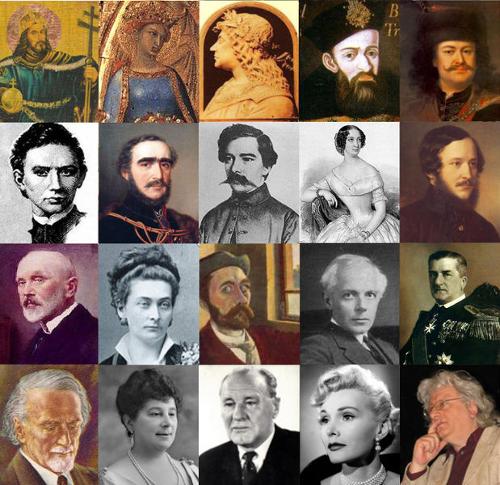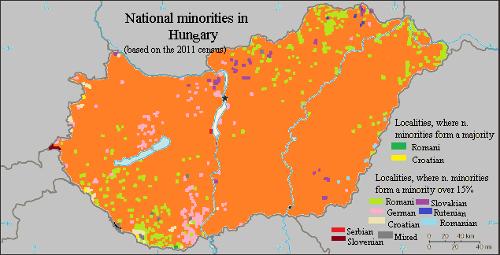HUNGARY
Population

Population
Cities in HUNGARY
| Budapest |
Population
Composition and distribution
 Famous Hungarians, top to bottom and left to right: Stephen I of Hungary, St. Elizabeth of Hungary, Matthias Corvinus, Gábor Bethlen, Ferenc Rákóczi, János Bolyai, István Széchenyi, János Arany, Róza Laborfalvi, József Eötvös, Loránd Eötvö , Vilma Hugonnai, Tivadar Kosztka, Béla Bartók, Miklós Horthy, Zoltán Kodály, Emma Orczy, János Kádár, Zsa Zsa Gabor, Péter EsterházyPhoto: Fakirbakir CC 3.0 Unported no changes made
Famous Hungarians, top to bottom and left to right: Stephen I of Hungary, St. Elizabeth of Hungary, Matthias Corvinus, Gábor Bethlen, Ferenc Rákóczi, János Bolyai, István Széchenyi, János Arany, Róza Laborfalvi, József Eötvös, Loránd Eötvö , Vilma Hugonnai, Tivadar Kosztka, Béla Bartók, Miklós Horthy, Zoltán Kodály, Emma Orczy, János Kádár, Zsa Zsa Gabor, Péter EsterházyPhoto: Fakirbakir CC 3.0 Unported no changes made
A total of 9,855,000 people lived in Hungary in 2024, which equates to approximately 110 per km2.
84.3% of the population consists of Hungarians or Magyars. The main minority groups are Germans, Slovaks, Serbs, Croats, Romanians and Roma.
The population is slowly declining due to a low birth rate, a high death rate and an emigration surplus. The growth rate was -0.28% in 2017. Positive are the small decrease in the mortality rate in recent years and the very rapid decrease in infant mortality. Every year, the population is still decreasing by several tens of thousands of people, partly because hardly any people immigrate to Hungary.
Life expectancy at birth is 79.3 years for women and 72.9 years for men. The composition of the population is as follows:
0-14 years 14.6%
15-64 years 63.9%
65+ 21,5%
73% of the population live in the cities and 27% in the countryside. A large part of the population (approx. 1.8 million inhabitants) lives in the capital Budapest, and there live approx. 4000 people per km2!
The most densely populated are the provinces of Komárom and Pest (around Budapest), Borsod-Abauj-Zemplén in the north and Csongrád in the southeast. The least populated are the provinces of Somogy, and Bács-Kiskun with 58 and 67 inhabitants per km2 respectively.
Due to border changes after the First World War, at the Treaty of Trianon, Hungary lost 70% of original territory and two-thirds of the population at that time. As a result, many Hungarians live in Hungary's neighboring states: in Romania there are more than 2 million people of Hungarian descent, in Slovakia about 700,000, in Serbia;approx. 400,000, in Ukraine approx. 200,000 and in Croatia and Slovenia several tens of thousands. In addition, Hungary, along with Russia, is the European country with the most citizens residing outside their country, about 1.5 million in Europe and in the Americas.
Minorities
 Minorities in HungaryPhoto: Szabi237 CC 4.0 International no changes made
Minorities in HungaryPhoto: Szabi237 CC 4.0 International no changes made
The approximately 100,000 Slovaks and Wends are the oldest minority. They live mainly in the border area with Slovakia and furthermore in the region of Orség between the rivers Rába and Múra.
The approximately 220,000 Germans mainly came to Hungary in the 13th and 18th centuries.
The approx. 25,000 Romanians live in the suburbs of Gyula and the nearby village of Méhkerék.
Approximately 100,000 Serbs and Croats live there. The Serbs live in cities on the Danube, such as Szentendre, Buda, Baja and Ráckeve.
The Croats live in Mohács and in villages along the Dráva.
The approximately 300,000 Roma (gypsies) live spread across the country, but mainly in the northeast. Almost 90% of them now have a permanent place of residence.
As is so often the case, they are not considered a separate people and therefore do not appear in Hungarian statistics. The first Roma settled in Hungary in the 15th century from the north of India and consist of three groups: the mostly Hungarian-speaking Romungros (70%), the Walachian native and initially only Romanesch (gypsy) speaking Walach gypsies (20%) and the Romanian-speaking Beázs Gypsies (10%).
The social status of the Roma, many have no work and are looked at by the Hungarians. Yet many have already built up a good social position and are trying to help others to achieve that too. They mainly live on the outskirts of large cities. In cities such as Miskolc, Debrecen and Nyíregyháza they represent about 15% of the population.
Sources
Boedapest en Hongarije
Michelin Reisuitgaven
Fallon, S. / Hungary
Lonely Planet
Hongarije
Lannoo
Hoogendoorn, H. / Hongarije
ANWB
CIA - World Factbook
BBC - Country Profiles
Last updated December 2025Copyright: Team The World of Info